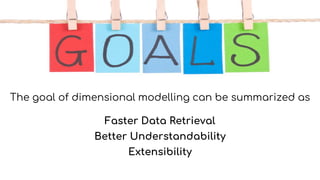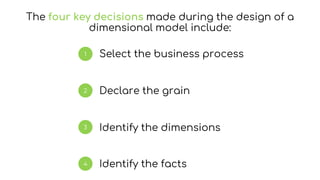UML, ER and Dimensional Modelling
- 1. UML, ER and DIMENSIONAL MODELS S t e f a n o D a l l a P a l m a
- 2. A model is an abstraction that describe a system
- 3. Software size grows up rapidly
- 8. UML is way of visualizing a software program using diagrams Class Diagram Object Diagram Package Diagram Component Diagram Deployment Diagram Composite Structure Diagram Sequence Diagram Activity Diagram Use case Diagram Collaborative Diagram Statechart Diagram Structural diagrams Behavioural diagrams
- 9. UML is way of visualizing a software program using diagrams Class Diagram Object Diagram Package Diagram Component Diagram Deployment Diagram Composite Structure Diagram Structural diagrams Behavioural diagrams Activity Diagram Use case Diagram Collaborative Diagram Statechart Diagram Sequence Diagram
- 10. Why do we use UML? A complex enterprise application with many collaborators will require a solid foundation of planning and clear, concise communication among team members as the project advance. Visualizing user interactions, processes, and the structure of the system you're trying to build will help save time down the line and make sure everyone on the team is on the same page.
- 11. Use Case diagram
- 12. ActorName Actor Actors are roles, external entities (users, systems, environment) that interact with the system
- 13. UseCaseName A use case is a class of functionalities provided by the system as events flow. It consists of an unique name, participating actors, entry conditions, event flows, exit conditions, special requirements Use Case
- 15. Include UC2 <<include>> UC1 Include is used to extract use case fragments that are duplicated in multiple use cases for the purpose of reuse
- 16. ATMUser DepositCash WithdrawCash TransferFunds Authenticate <<include>> <<include>> <<include>>
- 17. Extend UC2 <<extend>> UC1 Extend models exceptional or rare cases It is used when a use case adds steps to another first- class use case
- 18. ATMUser DepositCash WithdrawCash TransferFunds Cancel <<extend>> <<extend>><<extend>> CardNotSupported
- 19. Inheritance Inheritance models the hierarchy between actors and use cases. It is used to specialize a more general use case adding more details UC2UC1
- 20. ATMUser DepositCash WithdrawCash TransferFunds Authenticate <<include>> <<include>> <<include>> AuthenticateWithPin AuthenticateWithFingerprint
- 21. Class diagram
- 22. Class
- 23. Access modifier All classes have different access levels – visibility – depending on the access modifier Visibility markers signify who can access the information contained within a class
- 26. Inheritance Inheritance (or generalization) is a relationship between two classes where one class is a specialized version of another
- 29. Associations Associations model static relationships between classes Unidirectional association Bidirectional association
- 30. In a unidirectional association one class is aware of the other and interact with it It is modelled with a straight connecting line that points an open arrowhead from knowing class to the known class
- 31. In a bidirectional association both classes are aware of each other and their relationships with the other Association name* 0…1 Multiplicity Role Role Reading direction
- 36. Binary association hasCapital 1 1 administers 1 * attends * * 1-to-1 association 1-to-many association many-to-many association
- 37. n-ary association: more than two classes are involved in the relationship * * 0…1 examiner Grade Ternary association class
- 38. Association class is necessary when modeling many-to-many associations. It is possible, but not necessary, when modeling 1- to-1 or 1-to-many associations * Association class * *1
- 39. * Association class * *1 Association class is necessary when modeling many-to-many associations. It is possible, but not necessary, when modeling 1- to-1 or 1-to-many associations
- 40. Dependency A dependency is a relationship between two elements in which a change to an independent element can have repercussions on a dependent element Class A depends on class B, which means that changing the structure or the behaviour of B could affect the structure or the behaviour of A Independent classDependent class
- 41. Aggregation Aggregation is a special association that denotes a “consist of” hierarchy between a class A, the aggregate, and a class B, its part. It is used to express that a class is part of another class. Aggregation is a weak ownership between two classes, meaning that parts can exist independently of the whole
- 42. 4,4 2,5 0,1* * 1,* Student is part of a lab class Course is part of a study program A car consist of an engine, a battery, four wheel and at least two doors and maximum five doors
- 43. Composition Composition is a special type of aggregation that denotes a strong ownership between class A, the whole, and class B, its part. There exists a dependency between the two classes. If the composite object (the whole) is deleted, also its parts are deleted. Furthermore, one part can only be contained in at most one composite object at one specific point in time 1
- 44. Lecture hall is part of the building. If the building is deleted, the lecture hall is also deleted City is part of the Country and the Country is part of the World. If the Country is deleted, the City is also deleted. If the World is deleted… 1 11 * * *
- 45. Apocalypse
- 46. Sequence diagram
- 47. describe interactions among classes, or among actors and the system, in terms of an exchange of messages over time Sequence diagrams
- 48. Participant Participant (or class role) describe the way an object will behave in context. Use the UML object symbols to illustrate roles, but don’t list object attributes
- 49. Lifeline Lifelines are vertical dashed lines that indicate the object's presence over time. Theyrepresent either roles or object instances that participate in the sequence being modelled
- 50. Execution Occurrence Activation boxes represent the time an object needs to complete a task. When an object is busy executing a process or waiting for a reply message, use a thin rectangle placed vertically on its lifeline
- 51. Messages Messages are arrows that represent communication between objects The message (or method) name is placed above the arrowed line. The message that is being sent to the receiving object represents an operation (or method) that the receiving object's class implements.
- 52. Synchronous message A synchronous message requires a response before the interaction can continue. It's usually drawn using a line with a solid arrowhead pointing from one object to another
- 53. Asynchronous message An asynchronous message doesn’t need a reply for interaction to continue. Like synchronous messages, they are drawn with an arrow connecting two lifelines; however, the arrowhead is usually opened and there is no return message depicted
- 54. Reply message A reply message is drawn with a dotted line and an open arrowhead pointing back to the original lifeline
- 55. Self message A self message is a message an object sends to itself, usually shown as a U shaped arrow pointing back to itself
- 56. Create message A create message creates an new object. Similar to a return message, it’s depicted with a dashed line and an open arrowhead that points to the rectangle representing the object created
- 57. Destroy message A destroy message destroys an object. It can be shown by an arrow with an X at the end
- 59. Sequence diagrams represent the dynamic behaviour of the system in term of interactions between objects and actors They are complementary to class diagrams. That is, with class diagrams one knowns the static structure of a systems and relationships between classes, but not how classes interact each other over time They require a lot of time, but it’s worth it! The reason the sequence diagram is so useful is because it shows the interaction logic between the objects in the system in the time order that the interactions take place
- 60. Activity diagram
- 61. illustrate dynamic nature of the system by modelling the flow of control from activity to activity. An activity is an operation on some class in the system that results in a change in the state of the system. Typically, activity diagrams are used to model workflow or business process and internal operations Activity diagrams
- 62. Initial state Initial state (or start point) is shown by a small filled circle followed by an arrow and represents the initial action or the start point for any activity diagram
- 63. Activity An activity (or action state) represents an ongoing execution of a step in a workflow (such as an operation or a transaction) that results in a change of the system state Activity
- 64. Action flow Action flows, also called edges and paths, illustrate transitions from one activity state to another
- 65. Branching A diamond represents a decision (or branch) with alternate paths When an activity requires a decision prior to moving on the next activity, add a diamond between the two activities. The outgoing alternatives should be labelled with a condition or guard expression. Guards are statements that must be true before moving to the next activity Guards [“Condition” is true] [“Condition” is false]
- 67. Synchronization A fork node is used to split a single incoming flow into multiple concurrent flows. A join node joins multiple concurrent flows back into a single outgoing flow. A fork and join node used together are often referred to as synchronization Fork node Join node
- 68. Final state A final state is shown by a small filled circle nested inside another empty circle and represents the final action state for any activity diagram
- 71. What is a database? A database is a collection of correlated data organized in a systematic way. With “data” we mean known facts that can be stored. For example the name, surname and birthdate of a person. A database must represent the aspects of the real world under consideration, called miniworld. It must contain correlated data. Indeed, a random collection of data cannot be considered a database. Finally, it must be designed for a specific use. A database can have any size and complexity.
- 72. A phonebook is a small database
- 73. What about Facebook and Google databases?
- 74. 4.000.000.000.000.000 bytes of data are stored by Facebook every day
- 75. The equivalent of 14 billions high quality 3 minutes songs
- 78. Example: University We want to realize a database for the University to manage students, courses (with prerequisites) and passed exams. We can organize it in 4 entities: 1. STUDENT: contains data associated to each student 2. COURSE: contains data associated to each course 3. PREREQUISITES: contains the prerequisites for attending each course. 4. GRADE: contains data about the grades for each student and each exam. To define the database, we need to specify the structure of each entity. That is, we have to specify attributes (data element) of each record and the type of each data element.
- 81. A data model is a set of concepts that can be used to describe the structure of a database, that is, (1) the types of data, (2) relationships between data and (3) semantic constraints on data Data Model
- 82. Data models are classified depending on the concepts used to describe the structure of the database High level data models (or conceptual data model): provide concepts that are near to the way the user perceive the data. Representational data models (or implementational data models): provide concepts comprehensible by the final users, but that are not so distant from the way they are physically organized. Low-lever data models (or physical data models): provide concepts that describe details on how data are stored on the machine.
- 83. Data models are classified depending on the concepts used to describe the structure of the database High level data models (or conceptual data model): provide concepts that are near to the way the user perceive the data. Representational data models (or implementational data models): provide concepts comprehensible by the final users, but that are not so distant from the way they are physically organized. Low-lever data models (or physical data models): provide concepts that describe details on how data are stored on the machine. High level data models use concepts such as entities, attributes and relationships STUDENT Name Student Number Year COURSE Name Semester Lecturer PREREQUISITES Course Propaedeucity Lecturer GRADE Student Course Grade
- 84. Entity An entity is a class of specific objects (facts, persons, vehicles or otherwise) which have common properties and are represented in the database
- 85. It can be either a physical object or abstract
- 86. Attribute Attributes are properties that describe an entity
- 87. The entity Employee has the attributes Name, Surname, Salary, Birthdate and Address
- 88. Separable More values Calculable There exist several types of attribute
- 89. Multi-valued Attribute A multivalued attribute is an attribute that can have multiple value
- 90. Key attribute A key attribute is an attribute that has a unique value for the entity. More attributes together can form a key attribute. In such a case those attributes can be grouped in a composite attribute that becomes a “key attribute”
- 92. Hi, sure. Tell me more about it. Hi dude! I need a database for my Company. Can you help me? Mmm… got it. What about employees? The company is organized in departments and each department has a name, a number that identifies it and an employee the manage it (a manager). We need to keep track of the manager’s start date. Each department manages several projects. Each project has a name, a number and a single location. A department, instead, can have multiple location. The Company database example
- 93. For each employee we need to keep track of its name, SSN, address, salary, sex and birthdate. Each employee works for a department and can work on more projects. We also want to memorize the total weekly hours that an employee has spent on a project and the supervisor of each employee. Finally, each employee has a list of dependents for which we store name, sex, birthdate and relationship with the employee. Ok bro! I will work on it and I’ll let you know. See ya!
- 94. The company is organized in departments and each department has a name, a number that identifies it and an employee that manage it (a manager). We need to keep track of the manager’s start date. Each department manages several projects. Each project has a name, a number and a single location. A department, instead, can have multiple location. Let’s find the entities!
- 96. For each employee we need to keep track of its name, SSN, address, salary, sex and birthdate. Each employee works for a department and can work on more projects. We also want to memorize the total weekly hours that an employee has spent on a project and the supervisor of each employee. Finally, each employee has a list of dependents for which we store name, sex, birthdate and relationship with the employee. Let’s find the entities!
- 98. The initial design is typically not complete. Some aspects in the requirements will be represented as relationships. Indeed, now we have to represent the fact that an employee can work on multiple projects and the total weekly hours of an employee on each project. We also need to represent the fact that an employee manage a department and when she start doing it and the fact that each employee has a supervisor
- 99. Relationship A relationship relates two or more entities with a specific meaning A diamond-shaped box is used to display a relationship type connected to the participating entity types via straight lines. Note that the relationship type is not shown with an arrow. The name should be typically be readable from left to right and top to bottom Relationship Name
- 100. Many-to-One
- 101. Many-to-Many
- 102. Constraint on Relationship Each relationship type has constraints that limit the possible entity combinations that can participate to its instances. They are determined by the context of the mini-world that the relationship represent. We can distinguish between two types of constraint (1) Cardinality Ratio and (2) Participation Constraint Relationship NameCardinality Cardinality (min, max)(min, max)
- 103. Cardinality Ratio The Cardinality Ratio specifies the minimum and maximum number of instances that can participate to the relationship. A cardinality ration can have any positive number, with the constraint that the minimum cardinality must be lower than or equals to the maximum cardinality. The minimum cardinality can be omitted, but the maximum cardinality must always be present Relationship Name (min, max) (min, max)
- 104. Participation Constraint The Participation Constraint specifies the minimum number of instances that can participate to the relationship. That is, it specifies whether the existence of an entity depends on another entity. There exist two types (1) Mandatory participation and (2) Optional participation Relationship Name (1, max) (0, max) Mandatory Optional
- 105. Relationship Name Relationship Name Mandatory Optional OptionalMandatory Different representations of mandatory and optional partecipation
- 106. (1,1) (0,N) The following is a N-to-1 relationship. Each department can have zero or more employees (0,N) and an employee can work for only one department (1,1). The participation is mandatory for the entity Employee and optional for the entity Department Mandatory participation means that each instance in the set of the entity Employee must be related to the entity department (0,1) (1,1) The following is a 1-to-1 relationship. A department can be managed by only one employee and an employee can manage at maximum one department. Therefore, the relationship is mandatory for the entity type department and optional for the entity employee
- 107. When a type of entity participates to a relationship type more than once with different roles we refer to those relationships as recursive. Role Name Recursive Relationship Any entity that participate to some type of relationship has a role. The name of the role specifies the role the entity has in each instance of the relationship. For example, in a “MARRIED_TO” relationship an entity PERSON can have the role either of husband or wife. Role 1 Role 2
- 108. […] each department has […] an employee that manage it (a manager). We need to keep track of the manager’s start date. Each department manages several projects. […] Each employee works for a department and can work on more projects. We also want to memorize the total weekly hours that an employee has spent on a project and the supervisor of each employee. Finally, each employee has a list of dependents […]. Let’s find the relationships!
- 113. Why do we use Dimensional Modelling? All the modelling techniques give us different ways to store the data. Different ways of storing data gives us different advantages. For example, ER Modelling gives us the advantage of storing data is such a way that there is less redundancy. Dimensional modelling, on the other hand, give us the advantage of storing data in such a fashion that it is easier to retrieve the information from the data once the data is stored in database. Be careful! dimensional model is not a good solution if your primary purpose of your data modeling is to reduce storage space requirement, reduce redundancy, speed-up loading time etc.
- 114. Dimensional Model is a database structure that is optimized for online queries and Data Warehousing tools. It consits of dimensions and facts Dimensions are the objects of context, that is, things about something is being spoken, and are the entry points for getting at the facts Facts are numeric values that a business whishes to count
- 115. Dimensional Models are designed for reading, summarizing and analyzing numeric information, whereas Relational Models are optimized for adding and maintaining data using real-time operational systems.
- 116. The goal of dimensional modelling can be summarized as Faster Data Retrieval Better Understandability Extensibility
- 117. The four key decisions made during the design of a dimensional model include: Select the business process Declare the grain Identify the facts Identify the dimensions
- 118. Select the business process Business processes are the operational activities performed by your organization, such as taking an order, processing an insurance claim, registering students for a class, or snapshotting every account each month. Business process events generate or capture performance metrics that translate into facts in a fact table. Most fact tables focus on the results of a single business process. Choosing the process is important because it defines a specific design target and allows the grain, dimensions, and facts to be declared. Each business process corresponds to a row in the enterprise data warehouse bus matrix
- 119. Declare the grain Declaring the grain is the pivotal step in a dimensional design. The grain establishes exactly what a single fact table row represents. The grain declaration becomes a binding contract on the design. The grain must be declared before choosing dimensions or facts because every candidate dimension or fact must be consistent with the grain. This consistency enforces a uniformity on all dimensional designs that is critical to Business Intelligence application performance and ease of use. Atomic grain refers to the lowest level at which data is captured by a given business process. You should start by focusing on atomic-grained data because it withstands the assault of unpredictable user queries
- 120. Identify the dimensions Dimensions provide the “who, what, where, when, why, and how” context surrounding a business process event. Dimension tables contain the descriptive attributes used by applications for filtering and grouping the facts. With the grain of a fact table firmly in mind, all the possible dimensions can be identified. Whenever possible, a dimension should be single valued when associated with a given fact row. Dimension tables are sometimes called the “soul” of the data warehouse because they contain the entry points and descriptive labels that enable the Data Warehouse/Business Intelligence system to be leveraged for business analysis. A disproportionate amount of effort is put into the data governance and development of dimension tables because they are the drivers of the user’s BI experience.
- 121. Identify the facts Facts are the measurements that result from a business process event and are almost always numeric. A single fact table row has a one-to-one relationship to a measurement event as described by the fact table’s grain. Thus a fact table corresponds to a physical observable event, and not to the demands of a particular report. Within a fact table, only facts consistent with the declared grain are allowed. For example, in a retail sales transaction, the quantity of a product sold and its extended price are good facts, whereas the store manager’s salary is disallowed. A Fact Table consists of one or more numeric facts of importance to a business. At the lowest grain, a fact table row corresponds to a measurement event and vice versa. In addition to numeric measures, a fact table always contains foreign keys for each of its associated dimensions. Details about the dimensions (e.g customer name, customer address) are stored in the dimension table (i.e. customer).
- 122. Identify dimensions In the above statement, we are speaking about 3 different things - we are speaking about food, some specific McDonald’s store and some specific day. Burgers and fries are two different members of food dimension. We will have to create separate tables for separate dimensions The business objective is to create a data model that can store, and report number of burgers and fries sold from a specific McDonald’s outlet per day
- 123. Identify facts In the above statement, the number of burgers/fries sold is a measure. Examples of facts are the number of products sold, the value of products sold, the number of products produced and the number of service calls received Businesses have a need to monitor these facts closely and to sum them using different dimensions: 1. The value of products sold this quarter versus last quarter 2. The value of products sold by store 3. The value of products sold by channel (e.g. delivery apps, in-store shopping, etc.) Businesses will often need to sum facts by multiple dimensions: 1. The value of products sold store, by product type and by day of week 2. The value of products sold by product and by channel The business objective is to create a data model that can store, and report number of burgers and fries sold from a specific McDonald’s outlet per day
- 124. Identify the attributes or properties of dimensions We need to know what are the properties or attributes of each dimension that we need to store in our table. This is important since knowing the properties let us decide what columns are required to be created in each dimension table. Each dimension might have number of different properties, but for a given context, not all of them are relevant for us. As an example, let's take the dimension food. We can think of so many different attributes of food - e.g. names of the food, price of the food, total calories in the food, colour of the food and so on. But we need to check which of these attributes are relevant to us - that is - which of these attributes are required for reporting on this data. As for the given statement above, we just need to know only one attribute of the food dimension - i.e. name of the food (burger or fries) The business objective is to create a data model that can store, and report number of burgers and fries sold from a specific McDonald’s outlet per day
- 127. Approaches to Dimensional Model Star Schema Multiple fact tables share dimension tables, viewed as a collection of stars, therefore called galaxy schema or fact constellation Snowflake Schema Facts Constellation A fact table in the middle connected to a set of dimension tables A refinement of star schema where some dimensional hierarchy is normalized into a set of smaller dimension tables, forming a shape similar to snowflake


















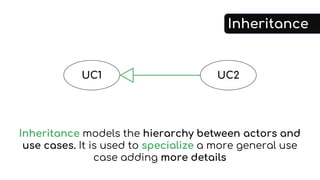














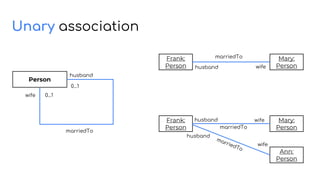






























![Branching
A diamond represents a decision (or branch) with
alternate paths
When an activity requires a decision prior to moving on the next
activity, add a diamond between the two activities. The outgoing
alternatives should be labelled with a condition or guard
expression. Guards are statements that must be true before moving
to the next activity
Guards
[“Condition” is true]
[“Condition” is false]](https://image.slidesharecdn.com/modelling-181029191627/85/UML-ER-and-Dimensional-Modelling-65-320.jpg)









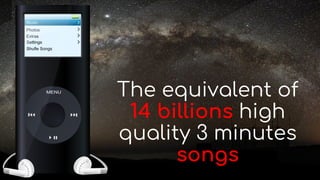















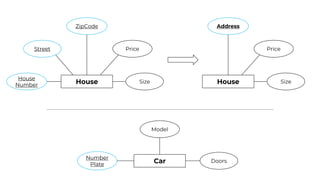















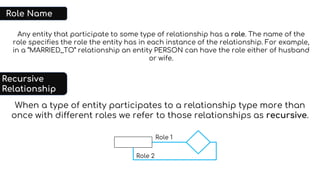
![[…] each department has […] an employee that manage it (a
manager). We need to keep track of the manager’s start date.
Each department manages several projects. […] Each
employee works for a department and can work on
more projects. We also want to memorize the total weekly hours
that an employee has spent on a project and the supervisor of
each employee. Finally, each employee has a list of
dependents […].
Let’s find the relationships!](https://image.slidesharecdn.com/modelling-181029191627/85/UML-ER-and-Dimensional-Modelling-108-320.jpg)







